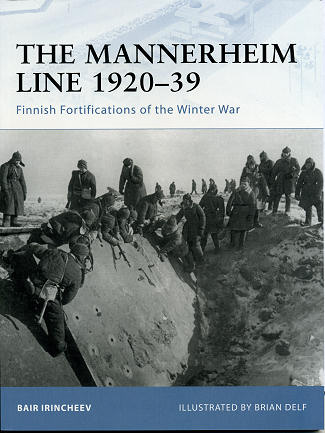 The
88th edition in Osprey's Fortress series concentrates on the fortifications of
the Mannerheim line across the Karelian Isthmus between Finland and the Soviet
Union. Finland had won its independence in 1917 from Russia in a particularly
hard fought civil war. With the advent of the Soviet Union, the Finns realized
that were there to be hostilities again, this isthmus would be the natural
avenue for an invading army so set out to establish a defensive line. The
Soviets were never comfortable about having a border so close to their second
major city, Petrograd (St.Petersburg/Leningrad), so were always wary of what the
Finns would be doing in the way of fortifications.
The
88th edition in Osprey's Fortress series concentrates on the fortifications of
the Mannerheim line across the Karelian Isthmus between Finland and the Soviet
Union. Finland had won its independence in 1917 from Russia in a particularly
hard fought civil war. With the advent of the Soviet Union, the Finns realized
that were there to be hostilities again, this isthmus would be the natural
avenue for an invading army so set out to establish a defensive line. The
Soviets were never comfortable about having a border so close to their second
major city, Petrograd (St.Petersburg/Leningrad), so were always wary of what the
Finns would be doing in the way of fortifications.
Typical of fixed installations, there were several periods of
construction with the earlier bunkers and installations good for the time they
were built, but insufficient for modern warfare. In the late 1930s, as war
seemed to be imminent, another set of upgraded installations was designed and
built. As it turns out, few of these installations were able to withstand the
intense bombardment provided by the Soviets when they invaded in November 1939
(the Winter War). Though the defenders were able to slow the onslaught, it was
such a one-sided war that the end was really never in doubt and the Finns lost
the isthmus and the forts within. With the end of fighting, the Soviets then
blew up the remains so that they would not be able to be used against them
again.
In this book, author Bair Irincheev has a look at the background
of the design and construction of the various emplacements and bunkers as well
as the weapons that were available to be used in these fortifications. There is
also a good look at the various field fortifications and obstacles that were
used to slow down the invading army. We also get a good idea of what it must have been like to
have lived in these places during that time.
The author then takes us into a look at how some of these
specific fortifications actually functioned during war. Like many, they were unable to
fulfill the task desired by their builders for various reasons, though some held
up particularly well. Though the remains of these are now in Russia and most are
little more than piles of rubble, some still have bits that are extant and the
author shows us what they are like today. As they are in Russia, none have been
preserved in any fashion and in fact, there is very little in the way of
artifacts from this time in either Finland or Russia.
This is all superbly illustrated by Brian Delf, giving us a look at how these forts developed and were sustained.
Add in a fine collection of photographs of the extant sites as well as
period photographs, and you have an excellent book on
a subject that is both historically significant and fascinating to read. It is
one I can highly recommend.
October 2009
For more on the complete line of Osprey books,
visit www.ospreypublishing.com. In the US, it is
Osprey Direct at 44-02 23rd St, Suite 219, Long Island City, NY 11101., where you can
get a catalogue of available books.
If you would like your product reviewed fairly and quickly, please contact
me or see other details in the Note to
Contributors.
 The
88th edition in Osprey's Fortress series concentrates on the fortifications of
the Mannerheim line across the Karelian Isthmus between Finland and the Soviet
Union. Finland had won its independence in 1917 from Russia in a particularly
hard fought civil war. With the advent of the Soviet Union, the Finns realized
that were there to be hostilities again, this isthmus would be the natural
avenue for an invading army so set out to establish a defensive line. The
Soviets were never comfortable about having a border so close to their second
major city, Petrograd (St.Petersburg/Leningrad), so were always wary of what the
Finns would be doing in the way of fortifications.
The
88th edition in Osprey's Fortress series concentrates on the fortifications of
the Mannerheim line across the Karelian Isthmus between Finland and the Soviet
Union. Finland had won its independence in 1917 from Russia in a particularly
hard fought civil war. With the advent of the Soviet Union, the Finns realized
that were there to be hostilities again, this isthmus would be the natural
avenue for an invading army so set out to establish a defensive line. The
Soviets were never comfortable about having a border so close to their second
major city, Petrograd (St.Petersburg/Leningrad), so were always wary of what the
Finns would be doing in the way of fortifications.